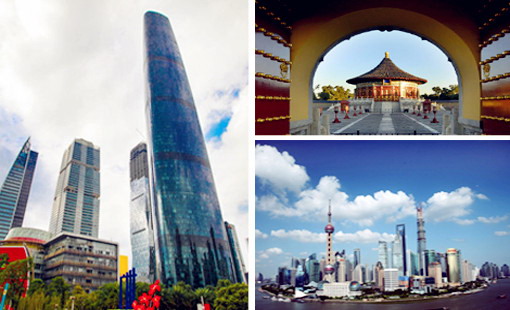China to overtake US as No 1 purchaser
Updated: 2013-08-15 23:40
By ZHANG YUWEI (China Daily)
|
||||||||
Even with the ongoing slowdown of China's economic growth, the world's second-largest economy is expected to overtake the United States to become the world's largest consumer market in the next five years, according to a report released by Standard & Poor's.
The report, entitled Financial Risks Are Rising as Retail and Consumer Product Companies Step Up their Spending Spree, pointed out that in 2012, total retail sales of consumer goods in China grew 14.3 percent to about $3.29 trillion, compared with $4.35 trillion in the more mature market of the US.
China's retail and consumer product industries are refining their growth strategies by looking outside of the domestic market for growth opportunities. Overseas acquisitions, said the report, are attractive options for Chinese consumer companies to improve product quality, increase differentiation, and acquire better brands.
The most recent example was the offer by China's largest meat producer, Shuanghui International Holdings Ltd, to buy Virginia-based Smithfield Foods Inc, the world's largest pork processor, for $7.1 billion, including a mixture of debt and $4.7 billion in cash.
The Shuanghui-Smithfield deal is currently being reviewed — for a second time — by the Committee on Foreign Investment in the United States. If it gets approved, it will become the largest takeover of a US firm by a Chinese buyer.
Shuanghui and Smithfield seem to be a perfect match.
"For many Western companies we rate — Yum Brands, Gap, General Motors, the German luxury automakers — Chinese consumer demand is already an important part of their business strategies," said Robert E. Schulz, managing director of S&P in New York.
Part of that strategy incorporates the interest of Chinese consumers in foreign brands, said Schulz, who manages the US retail team.
"So the ability of the domestic Chinese retailers to sell to the local consumer and compete with foreign brands is already a major factor in the competitive landscape," he said. "As the Chinese economy grows and the base of consumers with disposable income increases, selling locally should remain an attractive but competitive proposition for Chinese retailers."
Chinese investment in the US rocketed to $6.7 billion last year compared with $1 billion in 2008, according to research firm Rhodium Group, which tracks Chinese overseas investments.
In the first quarter of this year alone, Chinese companies spent $2.2 billion for eight acquisitions and nine greenfield projects in the US, according to Rhodium. Big transactions included Chinese automotive components firm Wanxiang Group Corp's $257 million purchase of the bankrupt Massachusetts-based battery maker A123 Systems LLC.
Wanxiang America — which employees about 6,000 people across the US — plans to do several merger and acquisition deals in the US to expand its business and brand recognition, said Ni Pin, president of the company's US operations."M&A is an important part of our business strategy here in the US," said Ni.
The S&P report said that M&A activities can strengthen business risk profiles and bring Chinese companies closer to peers in more mature markets.
And Chinese companies are also expanding in other markets.
Bright Food (Group) Co Ltd acquired United Kingdom-based cereal maker Weetabix Food Co in 2012 and Manassen Food Australia in 2011 to expand its product offerings and widen its access to international markets.
China's retail and consumer product companies have enough financial resources to satisfy their growth appetite, according to the S&P report.
"Many are sitting on huge piles of cash and have limited borrowings. They also have good access to the capital markets as a funding source. But the risks of overly ambitious takeovers are high," said the report.
While further expansion by Chinese consumer and retailers will grow, the track record for "organic international expansion" in overseas markets is mixed, noted the S&P's Schulz.
"Some restaurants and some apparel retailers have been moderately successful with organic growth in China," said Schulz. "There has not been a large amount of cross-border M&A in retail that we know of. Knowledge of the local customer is so very critical."
Despite some big deals made by Chinese firms in the overseas markets including in the US, the portfolio of industries is still small or limited mostly because retail is a local business and not all brands travel successfully to other markets, noted Schulz.
"There are probably more successful global fashion brands than restaurants, and even fewer global supermarket operators," said Schulz. "So whether it's a Chinese retailer or a European retailer electing to expand into a new overseas market, the challenges are not few — supply chain, critical mass, and local consumer preferences are just a few to consider."
Chinese brands also face the challenge of competing with well-established foreign brands, which often have gained strong brand appeal and are backed by solid financial resources as well as a global network, said Schulz.
"They will remain strong competitors in the global markets, and will likely become increasingly competitive in the Chinese local market," he said.

 Spielberg has desire to work with Zhang Yimou
Spielberg has desire to work with Zhang Yimou
 Li Na advances to 3rd round at Cincinnati Open
Li Na advances to 3rd round at Cincinnati Open
 Requiem ceremony for former comfort woman
Requiem ceremony for former comfort woman
 Egypt forces crush protesters
Egypt forces crush protesters
 Two killed in fiery crash of UPS cargo jet
Two killed in fiery crash of UPS cargo jet
 Yao dreams of sports for fun with towering charity
Yao dreams of sports for fun with towering charity
 Re-enacting ancestors' journey to the west
Re-enacting ancestors' journey to the west
 Special bus seat for breast-feeding mothers
Special bus seat for breast-feeding mothers
Most Viewed
Editor's Picks

|

|

|

|

|

|
Today's Top News
Havana seeks help to free 4 Cubans detained in US
Doctors took advantage of Michael Jackson
China lodges complaint over shrine visit
Vietnam opposes US shrimp anti-subsidy decision
China to launch fresh pharm bribery probe
US asks China's help on DPRK issues
Movie tax flack is settled
Manning 'sorry' for US secrets breach
US Weekly

|

|







